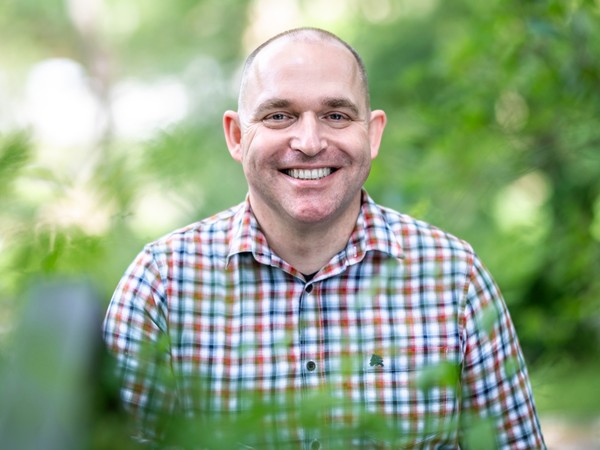Prof Ondřej Novák from the Palacký University Olomouc Faculty of Science and the Institute of Experimental Botany of the Czech Academy of Sciences has succeeded in a demanding international competition and won one of the most prestigious scientific grants of the European Research Council (ERC). His STARMORPH project, entered in the Synergy Grants category, was supported with €10 million and is focused on research into the role of the plant hormone auxin in plant growth and shaping.
Over the next six years, Prof Novák will be working on the project together with project coordinator Stéphanie Robert from the Swedish University of Agricultural Sciences in Uppsala, Jürgen Kleine-Vehn from the University of Freiburg, and Alexander Jones from the University of Cambridge.
“The composition of our international interdisciplinary team is exceptional, aiming to describe the complexities of plant morphogenesis in a way that no one has been able to before,” said Prof Ondřej Novák from the Laboratory of Growth Regulators, a joint workplace of the UP Faculty of Science and the Institute of Experimental Botany at the Czech Academy of Sciences. The knowledge gained from the project can be used in the future to increase crop yields, which can contribute to improved food security and sustainability.
“Receiving the ERC Synergy grant is a huge success for my colleague Ondřej Novák as an undisputed expert but also for our entire institute. It confirms that the institute is on the world’s leading edge in the field of plant hormone research. It is also a promise of new discoveries that have the potential to contribute to solving global problems brought about by climate change,” said Jan Martinec, Director of the Institute of Experimental Botany at the Czech Academy of Sciences.
Scientists in the STARMORPH project are using thale cress as the model plant to study the development of its apical hook, which plays a key role in the plant’s further growth and development after germinating from seed. The apical hook is the curved part of the stem near the top of the plant that allows the plant to emerge safely through the soil. The hook is formed by suppressing cell growth on the inside of the emerging stem. As soon as the seedling penetrates the soil to the surface, the cells on the inside start to elongate again and the hook unfurls. “This trait makes the apical hook a unique model for studying how a plant can regulate processes to suppress or promote cell growth. This is a very important topic to investigate because if we understand how to regulate plant growth, we could reprogramme this process in a targeted way,” said Prof Novák.
The phytohormone auxin, which will be the main focus of the STARMORPH project, plays a major role in differential growth, when different parts of plant organs grow at different rates. Depending on the concentration of auxin and its localisation in the plant tissue, cell elongation can be slowed down or accelerated, cell division can be stopped or promoted, and cells can be forced to specialise or allowed to return to an undifferentiated state.
Auxin signature
“The results of our research should reveal how the phytohormone auxin, mechanical signals, and developmental programmes interact together at multiple levels. The project introduces the concept of an ‘auxin signature’ which involves the dynamics of auxin within the plant cell in response to mechanical signals. For decades, scientists have focused on understanding the multiple roles of auxin, concentrating on its cellular and intercellular dynamics as well as auxin signalling through receptors in the cell nucleus. Most recently, new findings have emerged suggesting that auxin is perceived by different mechanisms in the nucleus, outside the nucleus, and in the space outside the cell,” said Novák.
According to Novák, the STARMORPH project uses an interdisciplinary approach combining plant physiology, cell biology, genetics, biophysics, synthetic biology, and bioanalytical chemistry. Four scientific teams will work together to investigate how changes in auxin distribution and concentration affect plant morphogenesis, i.e. plant shape and growth. “We will develop new chemical and bioengineering methods to map auxin inside cells and monitor its dynamics over time and space,” added Novák.
They will also try to understand if and how mechanical stimuli are linked to the auxin phytohormone. “This goal includes a detailed study of the mechanical properties of the cell wall and its influence on plant growth. Using genetics and biochemical methods, we will try to understand how mechanical signals and auxin dynamics together control morphogenesis at different levels, from cells to whole organs,” Novák said.
ECR Synergy Grants
ERC Synergy Grants are intended for multidisciplinary projects involving 2 to 4 research teams. Projects must demonstrate that the synergy between the scientists involved and their disciplines is central to the project and has the promise to deliver breakthrough discoveries. The total budget for this grant call in 2024 was €570 million. Out of the 540 projects evaluated, 56 were supported. Founded by the European Union in 2007, the ERC is Europe’s leading organisation for funding cutting-edge research.
An interview with Prof Ondrej Novák is available on the ECHO Přírody (Nature’s Echo) podcast on YouTube or Spotify.
Prof. Mgr. Ondřej Novák, Ph.D.
Ondřej Novák, a graduate of the Faculty of Science at Palacký University Olomouc, specialises in the biosynthesis and metabolism of plant hormones using the highly sensitive analytical method of mass spectrometry and the relationship between the chemical structure and biological activity of plant hormones. He has long been involved in the use of new modern bioanalytical techniques and simplification of extraction methods for the isolation of biologically active substances from complex biological samples. For six consecutive years, he has been one of the few scientists in the Czech Republic ranked among the top one percent of the world’s most cited scientists in the list of Highly Cited Researchers, published by Clarivate Analytics in the United States.
